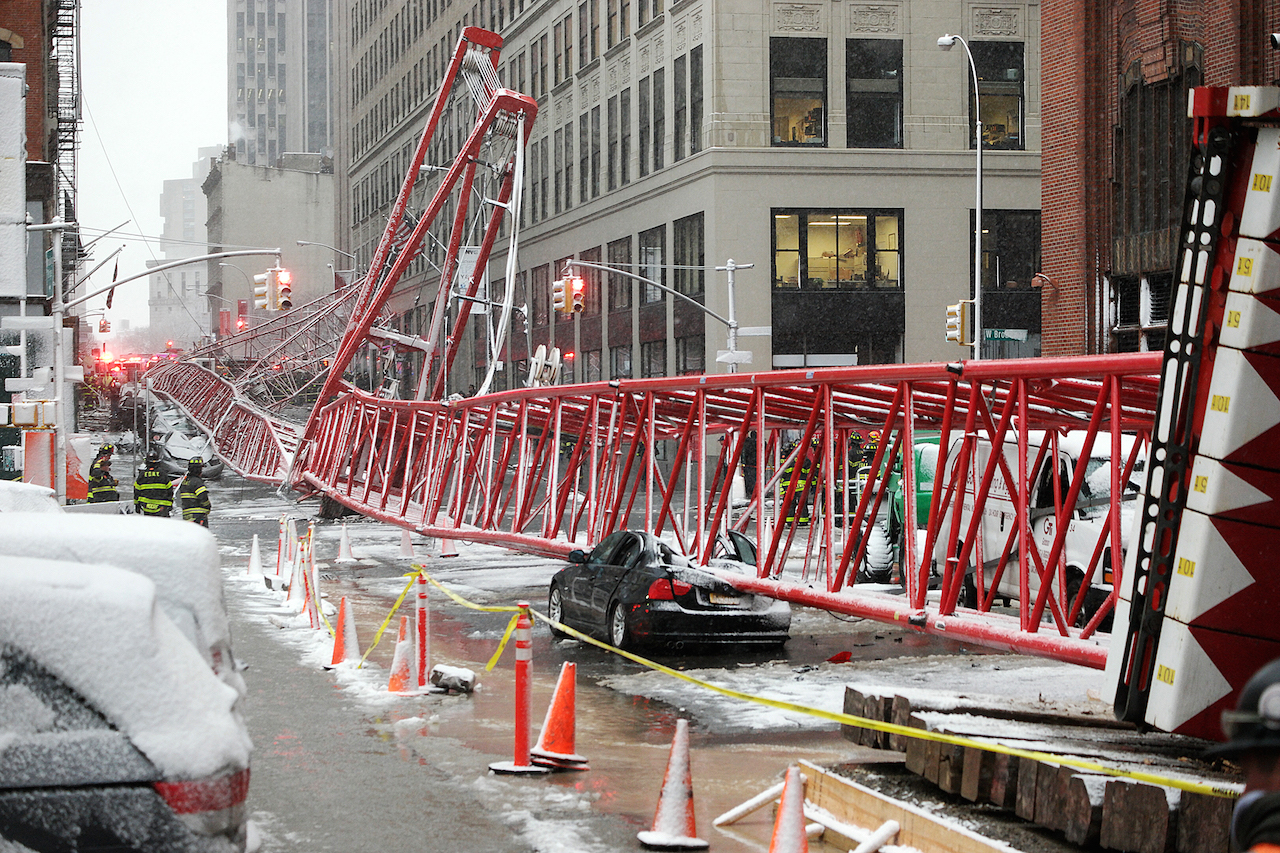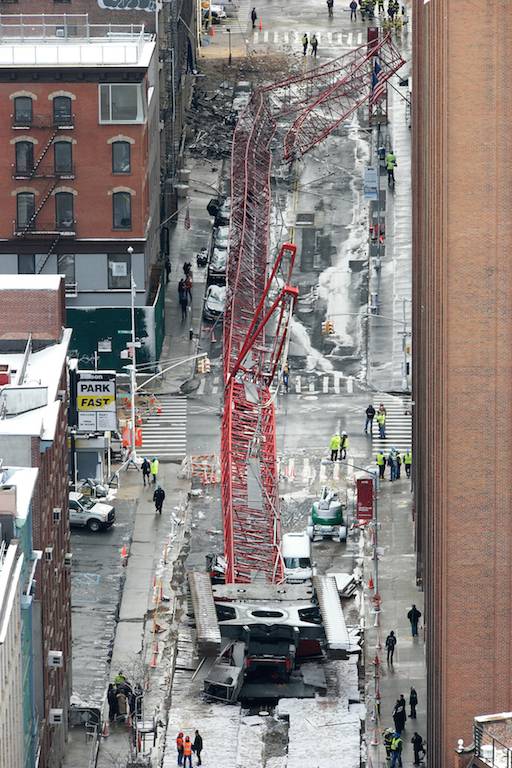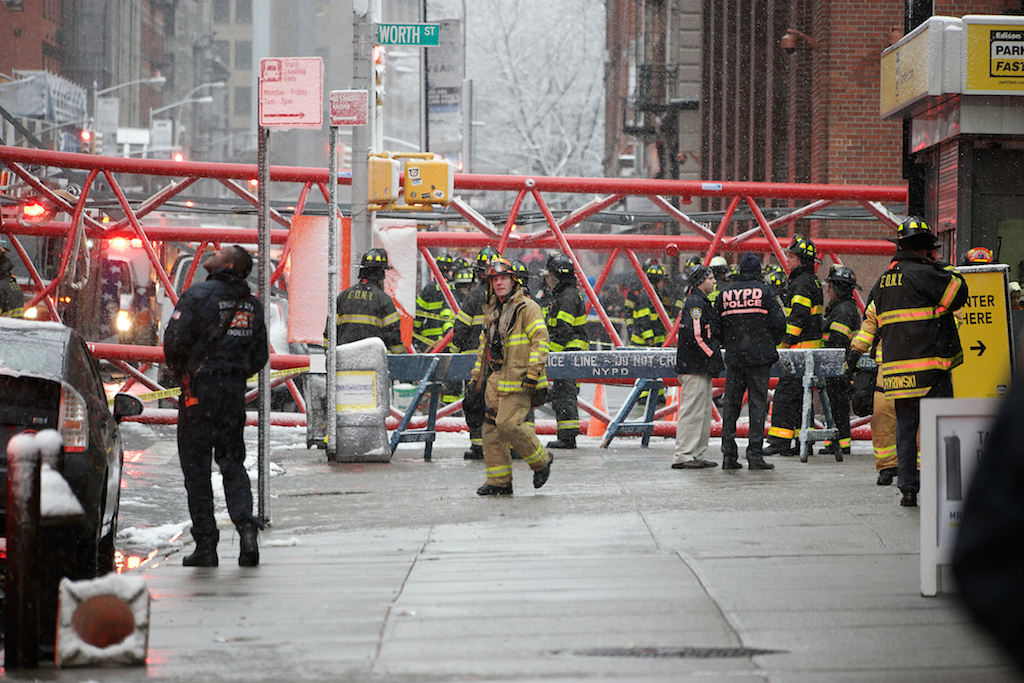
BY YANNIC RACK | Following last week’s deadly crane collapse in Tribeca, construction-weary Downtowners said that tightening safety rules would be useless if the city cuts back on oversight.
Two days after a 565-foot crawler crane toppled over onto Worth St. and crushed a 38-year-old Manhattan man, Mayor de Blasio announced new rules for securing cranes in high winds, and left open the possibility of further restrictions in the future.
“We’re going to leave no stone unturned in terms of learning from this accident and determining if we need other safety measures going forward,” the mayor said at a press conference in Tribeca on Sunday. “We all know there is a construction boom going on in our city, [but] there’s no building that is worth a person’s life.”
However, Lower Manhattan’s leaders say that the fatal accident shows the need not only for better safety rules, but also better coordination of Downtown’s many construction projects.
“We’ve been calling for more construction safety and coordination for a very long time now, and unfortunately we have a tragic wake-up call today,” Catherine McVay Hughes, chairperson of Community Board 1, said at a press conference in front of the toppled crane on Friday.
Hughes and fellow Downtown leaders said the crane crash came at a critical moment — right as the city’s Department of Transportation is preparing to shutter its office dedicated to coordinating construction projects in Lower Manhattan.
“We have got to put a stop to this,” said Councilmember Margaret Chin of the office’s imminent closure. “There’s too many construction projects down here and we need better coordination from the city.”
The department announced in December that it would be “phasing out” its Lower Manhattan borough commissioner’s office in March, due to lack of funding. The Downtown office is charged with inter-agency communication on about 90 major ongoing construction projects below Canal St.
“We’re urging the mayor to put more resources into the Lower Manhattan office, and we need more attention down here to make sure that this kind of tragedy does not happen again,” Chin said.
Neither the Mayor’s Office nor D.O.T. responded to a request for comment on the issue by press time.
The crane-safety plan the mayor announced Sunday requires crawler cranes — which move on treads, like a bulldozer — to be secured whenever steady winds are forecast to exceed 20 miles per hour, replacing the previous threshold of 25 miles per hour.
Fines for failure to safeguard equipment were more than doubled to $10,000, and rules on protecting pedestrian safety during crane operations and requirements for advance notification of crane activities were tightened.
Investigations into the crane collapse are ongoing, including a forensic investigation of the equipment, as well as probes by the police and D.O.B. On Friday, the mayor also ordered all of the city’s 376 active crawler cranes to be inspected by D.O.B. before they are put back into service.

The collapsed crane, which was based at the corner of Worth and Hudson Sts., toppled over just before 8:30 a.m., crashing down along two blocks of Worth St. As it fell, the crane damaged four neighboring buildings, raining debris down onto the sidewalk below.
David Wichs, a trading firm employee from the Upper West Side, was killed by the impact and three more people were hurt by falling debris, according to city officials. One of the injured, Thomas O’Brien, 73, was in serious condition with a head laceration, according to police. The two others sustained minor injuries.
For Downtown residents on Worth St., the extremely loud and incredibly close catastrophe evoked traumatic memories.
“We fell down in our apartment. It was worse than 9/11, the sensation,” said Bruce Ehrmann, who lives on the block where the crane was stationed and was at home with his wife when it collapsed. “She was screaming. We both were. It was terrifying.”
Diane Lapson, who lives nearby, said her daughter thought it was some sort of natural disaster.
“My daughter came out of her room and said, ‘Mom I think we just had an earthquake. My whole room shook,’ ” said Lapson.
Since Jan. 30, the crane, owned by Bay Crane and operated by Galasso Trucking and Rigging, was being used to replace generators and air-conditioning units atop the former Western Union Building at 60 Hudson St., and had been inspected the day before the crash by D.O.B., city officials said.
A crew had arrived there at 7 a.m. on Friday and was in the process of lowering the crane as a safety precaution due to strong winds, de Blasio said after the accident. There had been no construction work going on that morning.

After the collapse, more than 140 firefighters and emergency medical personnel from more than 40 units were deployed to the site, according to the Fire Department.
By Sunday, crews had chopped up and removed the crumpled crane from the street.
According to press reports, the crane’s 4,600-pound lifting hook was sent swinging into one of New York Law School’s fifth-floor offices, but luckily didn’t hurt anyone.
The mayor credited the crane’s crew — who had cleared the street of cars and pedestrians while working to secure the boom — for avoiding even worse carnage.
“It was something of a miracle that there wasn’t more impact,” de Blasio said, assessing the damage after the accident. “This is an area that would have normally had a lot of people around during rush hour.”
Not everyone was entirely surprised by the accident, though.
“I’m stunned, but not surprised,” said Ehrmann. “We’ve been predicting that this would happen since the crane went up.”
Ehrmann said he had taken a photo of the crane dangerously swaying in the wind just the night before and forwarded it to C.B. 1 Chairperson Hughes.
“The community has been very clear that construction coordination in Lower Manhattan is a huge concern, and that this construction site is a particular concern,” said state Senator Daniel Squadron after surveying the scene Friday.
Ehrmann, who is also on the community board, warned that residents could take matters into their own hands if the city doesn’t take action.
“There will be no more work on Worth St. from now on without the informed consent of the neighborhood. If it involves civil disobedience, that’s what we’ll do,” he said. “This is a wake-up call, and we will not allow it to happen again.”

















